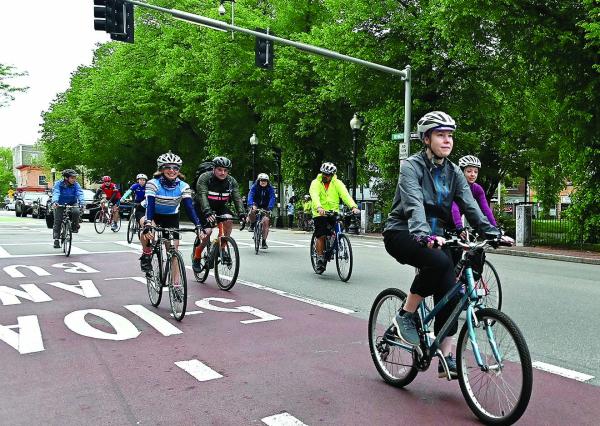June 1, 2022

Mayor Michelle Wu joined residents from Roslindale and West Roxbury for the annual Bike to Work send off at Adams Park in Roslindale Village on May 20. Mayor’s Office Photo by Isabel Leon
On May 20, 2022, as Boston celebrated National Bike to Work Day, coronavirus cases continued to ebb and flow. Since the start of the pandemic, I have biked from Dorchester to my job as a frontline provider. On my ride, the city looks very different than it did in March 2020, but in important and disappointing ways, it hasn’t changed at all.
If the mayor is serious about addressing health disparities and transit injustice laid bare by Covid, she should act quickly to improve biking infrastructure in places that need it most, like Dorchester.
Why? Well, we know that Black and Latino Bostonians have suffered disproportionately from this coronavirus. We know that communities with lower incomes, less insurance coverage, higher unemployment, and more essential workers were hit hardest. And we know that if we want to address the root cause of these disparities, we must look beyond hospitals and healthcare systems and focus on the social determinants of health.
These include the structural elements of our city that may appear to be unrelated to health at first glance, but nevertheless contribute to differences in death and disease, not just from Covid, but from many other conditions as well. These include, for example, how people from places like Dorchester commute to work.
Baseline transit inequities existed before the latest pandemic, but once the it struck, they got worse. The majority of transit riders were essential workers—mostly women and people of color in lower paying jobs, with limited access to cars, and no ability to work remotely.
Reduced transit service in Boston resulted in unsafe levels of crowding which in turn led to increased risk of Covid transmission in low-income riders despite increased precautions.
It’s no coincidence that the same people who made up our essential workforce were the same people crowding into trains and buses, living in the same neighborhoods that bore the lopsided brunt of infections.
Now consider the bicycle. Biking is particularly well suited to pandemic commuting. It is physically distanced, supports mental and physical health, reduces crowding in buses and trains, and does not take up precious parking. Cities across the world expanded bike infrastructure and budgets in response to the pandemic; bicycle sales surged and Boston was no exception.
Having more essential workers bike to work would be a good thing. Only a fraction need to pedal for us to reap the beneficial multiplier effects of decongestion. But to make bike commuting a viable option from Dorchester, it must be safer and much less stressful than it is now. We need better, protected bike lanes that connect our neighbors to their jobs – and more of them.
Unfortunately, biking is often thought of as a white, elitist mode of transportation and a harbinger of gentrification. Biking infrastructure is better in wealthy, affluent neighborhoods and neglected in poorer ones where the majority of bicyclists are non-white. In 2019, Boston got one of the lowest possible scores from Places for Bikes on “Reach” – the ability of a network to serve its citizens equally.
The reality, though, is that nationally, people from poorer neighborhoods and with lower incomes actually bike to work more. It may be that people who dominate the conversation about biking are not always representative of the majority of actual bikers.
So perhaps it is no surprise that while Boston has built new bike lanes since March 2020, they were not in the neighborhoods that needed them the most. We had the chance to build safer bike lanes for the most heavily affected communities during the first surge, when traffic was at an all-time low, but we chose to focus on downtown corridors instead.
That decision perpetuated the myth that biking to work is something only wealthy white people get to do. By enshrining that sense in infrastructure, it turned the myth into a self-fulfilling prophecy.
So, if we want to learn from our mistakes, we should build more protected bike lanes in Dorchester, Roxbury, and East Boston, where the majority of essential workers live. They have fewer bike lanes now, and fewer future bike lanes planned, compared to richer neighborhoods. The improvements to the Blue Hill Avenue corridor are a start, but not enough. They are also taking too long.
Dorchester is the most racially and economically diverse neighborhood in the city. Dorchester Avenue serves more than 50,000 people and has long been identified as being especially problematic for bikers; still, there have been no improvements made for them on the Ave during this pandemic, and nothing is in the works.
If we move rapidly to create a more accessible bike network in Dorchester, we will be doing more than protecting workers from Covid and whatever pandemic comes next.
We will be sending the message that the city means business when it comes to creating the lasting, structural change necessary to address the root causes of health disparities. We will be demonstrating a commitment to making urban cycling more inclusive, thereby alleviating some of the systemic racism inherent in our city’s transportation system. And we will be making a clear statement that the goal is not just to help vulnerable communities survive a pandemic, but also to thrive in its wake.
A more equitable Boston is a healthier, more resilient Boston. If it’s the city we want to see tomorrow, we need to start building it today, starting in Dorchester.
Lucas Marinacci, MD, is a Fellow in Cardiovascular Medicine at Beth Israel Deaconess Medical Center and a former Op-Ed Project Public Voices fellow. The views expressed are his own and do not reflect those of his employer.



